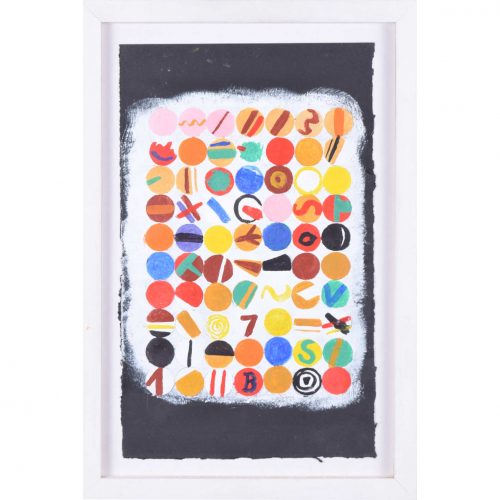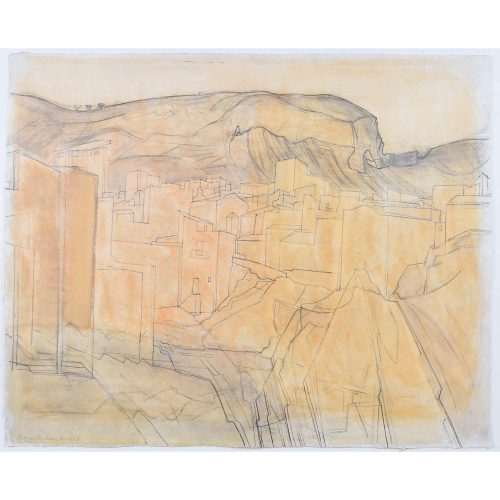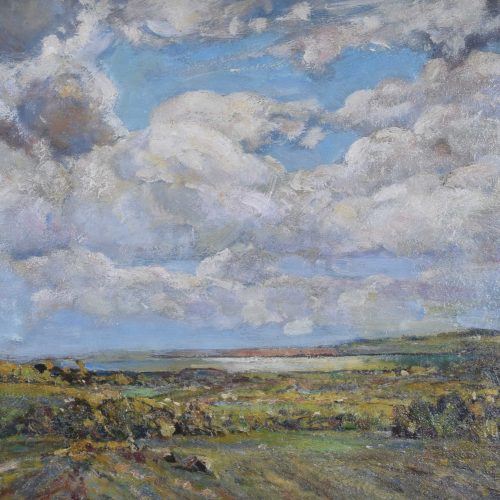-
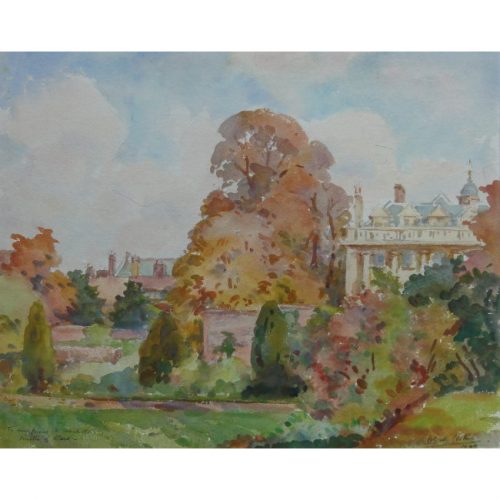
Wilfred Gabriel de Glehn RA (1870-1951)
Clare College from the Backs
Watercolour Inscribed “To my friend H Thirkill Master of Clare” Signed “W de Glehn, 1940” 40x50cm De Glehn painted Henry Thirkill in a portrait that is in the collection of Clare College and may be viewed here. Thirkill was Master between 1939 and 1958 and the portrait was commissioned in 1947. A versatile painter, skilled at portraiture, landscapes and figures de Glehn is regarded as one of England’s premier Impressionist painters. His ability to portray lighting in a lively fashion and his vibrant use of colour combine to provide wonderfully rich paintings. If you are interested email info@manningfineart.co.uk or call us on 07929 749056. -
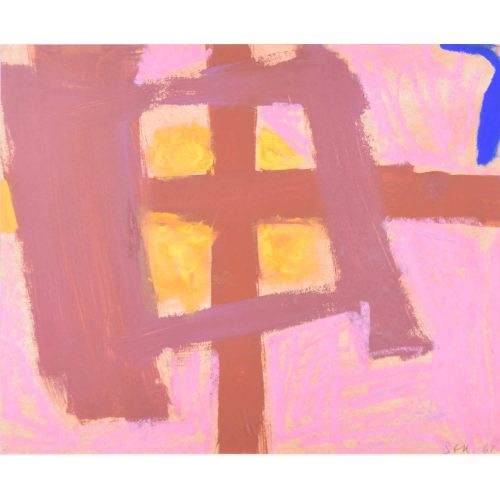
Trevor Bell (1930 - 2017)
Way Out Blue (1961)
Acrylic on paper 35 x 43 cm Signed and dated lower right. Bell's rosy-hued abstract composition is perhaps evoking an interior with window and curtains. The deep azure blue of the picture's title appears at the top right of the composition, curving away from the rest of the image. A sunny golden yellow drips in through the window panes, imbuing the scene with a hot, heady romanticism. Bell's idiosyncratic pictorial language allows us to experience the scene's hazy summer heat via the forms of sun, window, and wall. Bell was born in Leeds in 1930 and attended Leeds College of Art from 1947 to 1952 in a scholarship. The artist Terry Frost encouraged him to move to Cornwall, where he soon became a leading figure in the younger generation of the St Ives school. His first solo exhibition came in 1958, and the year after he was awarded the Paris Biennale International Painting Prize. The Tate began collecting his work in the 1960s, and Bell spent more time working and teaching in America. The Tate's 1985 St Ives exhibition featured Bell's work, and he was also included in the Tate St Ives' inaugural show. He returned from America in 1996 and settled down in isolated barn- and farmhouse-conversion studios near Penzance in Cornwall. He exhibited across England and America for the rest of his life, notably with his major solo exhibition at the Tate St Ives in 2004. Much of his work considers form and landscape via a dramatic use of colour and often on unusually-shaped (and sometimes multi-part) canvases. Condition: very good. If you’d like to know more, please email info@manningfineart.co.uk or call us on 07929 749056. -
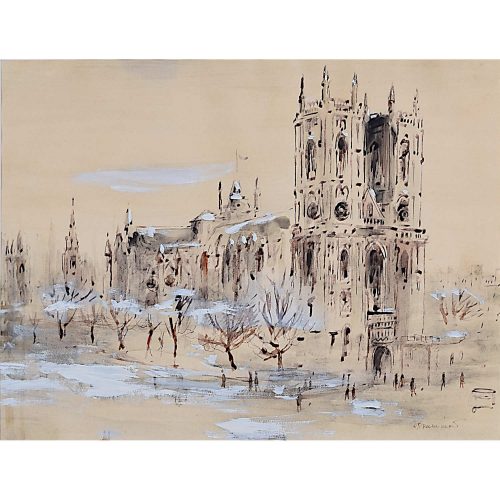
Violet Hilda Drummond (British, 1911-2000)
Westminster Abbey
Watercolour 33 x 43 cm Signed lower right. Here, the artist paints a sprightly view of Westminster Abbey, which rises from a sea of nondescript pedestrians. The mostly monochrome palette, gently highlighted with splashes of a muted red, and white details, communicates the character of the city. Drummond's father, a Scots Guard, was killed at Ypres in 1914. Drummond and her two sisters were brought up by her mother and educated in Eastbourne and at Le Chateau Vitry-sur-Seine, a Parisian finishing school. After Paris, Drummond attended St Martin’s School of Art. Later in life, she began writing children’s picture books – the most notable being Miss Anna Truly (1945) and her Little Laura series (1960 onwards). She also produced cartoons for the BBC. 'Mrs Easter and the Stork' – published in 1957 by Faber & Faber – was awarded the Kate Greenway Medal. Drummond later took to painting watercolours of London street scenes which have remained popular ever since. Provenance: the Arthur Andersen art collection. -
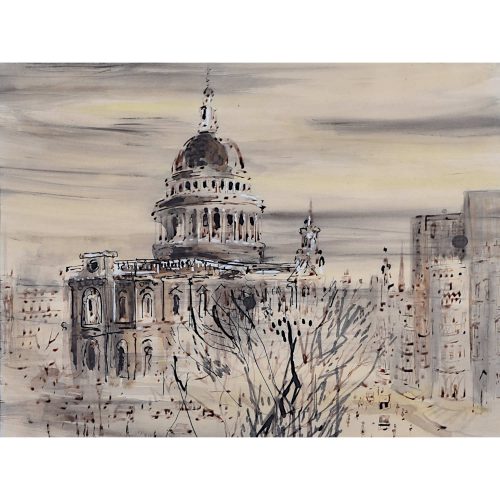
Violet Hilda Drummond (British, 1911-2000)
St Paul's Cathedral
Watercolour 33 x 43 cm Signed upper right (visible in the photograph showing the framed painting). Provenance: the Arthur Andersen art collection. Here, the artist paints a sprightly view of St Paul's, which rises from a sea of nondescript traffic and pedestrians. The mostly monochrome palette, gently highlighted with a yellow wash and white details, communicates the character of the city. Drummond's father, a Scots Guard, was killed at Ypres in 1914. Drummond and her two sisters were brought up by her mother and educated in Eastbourne and at Le Chateau Vitry-sur-Seine, a Parisian finishing school. After Paris, Drummond attended St Martin’s School of Art. Later in life, she began writing children’s picture books – the most notable being Miss Anna Truly (1945) and her Little Laura series (1960 onwards). She also produced cartoons for the BBC. 'Mrs Easter and the Stork' – published in 1957 by Faber & Faber – was awarded the Kate Greenway Medal. Drummond later took to painting watercolours of London street scenes which have remained popular ever since. -
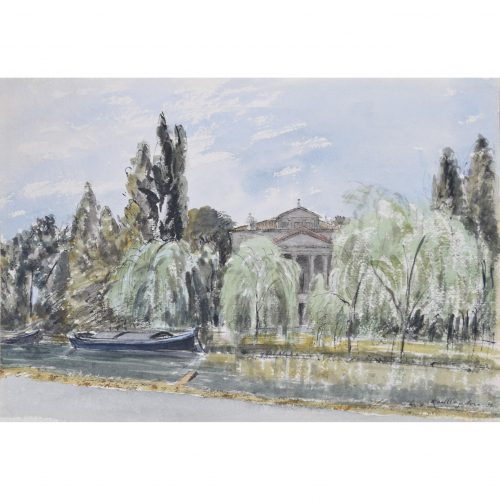
Karl Hagedorn (1889 - 1969)
The Villa Malcontenta, Venice (1958)
Watercolour and ink 33 x 50 cm Signed and dated 1958 lower right (dated August 23rd to reverse). A watercolour of the Villa Malcontenta in Venice, nestled between willow trees. The River Brenta flows serenely in the foreground. Villa Foscari is a patrician villa in Mira, near Venice, northern Italy, designed by the Italian Renaissance architect Andrea Palladio. It is also known as La Malcontenta ("The Discontented"), a nickname which - according to a legend - it received when the spouse of one of the Foscaris was locked up in the house because she allegedly did not live up to her conjugal duty. Karl Hagedorn was a painter and illustrator. He was educated in Berlin, and at the Manchester School of Technology, Manchester School of Art, and Slade School of Fine Art (where he later taught), before training in Paris under Maurice Denis. Hagedorn showed regularly at the Society of Modern Painters in Manchester, and then (from 1913 onwards), at the Royal Academy and the New English Art Club. He became a British citizen in 1914, and served in the British Army during World War I. During World War II, he sold pictures of military subjects to the United Kingdom Government's War Artists' Advisory Committee. He was also commissioned by the Recording Britain project to produce views of Middlesex and Derbyshire. Condition: very good. If you are interested, please email info@manningfineart.co.uk or call us on 07929 749056. Click here for more Modern British painting. -
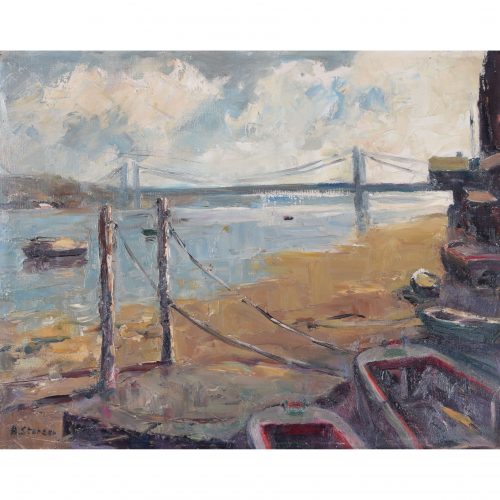
Angela Stones (1914 - 1995)
From Battersea Bridge (before Redevelopment)
Oil on board 40 x 50 cm Stones' view of the Thames and Chelsea Bridge, painted from Battersea Bridge. The artist's use of impasto, particularly evident in her depiction of the rambunctious white clouds above the bridge, lends a liveliness to the painting. Stones was educated at the Chelsea School of Art, and was a member of an artistic dynasty. Her mother Dorothy Bradshaw (1893-1983) studied under Jack Merriott – the artist famous for his British Rail posters, and her son, Christopher Assheton-Stones (1947-1999), was arguably the foremost pastel artist of his time. Provenance: the family of the artist. Condition: very good. If you’d like to know more, please email info@manningfineart.co.uk or call us on 07929 749056. -
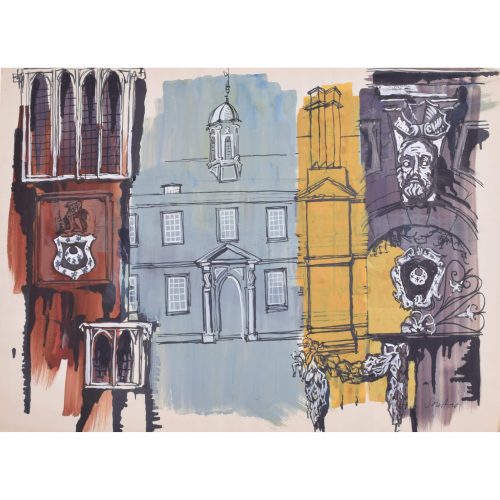
Margaret Souttar (1914 - 1987)
Trinity Hall, Cambridge V
Acrylic paint 56 x 72 cm Signed lower right. Souttar was a Scottish painter and printmaker known for her images of town- and cityscapes. In the early 1960s, she was commissioned to produce a series of prints of the Cambridge colleges. She captures the modernity and optimism of 1960s Cambridge; the fact that a female artist was commissioned to create the prints reflects the changing attitudes of the University towards women. Trinity Hall was one of the first Cambridge colleges to admit women as students – it did not do so until 1976. Provenance: the artist's studio sale. Condition: generally very good. If you are interested, please email info@manningfineart.co.uk or call us on 07929 749056. Click here for other views of Trinity Hall. -

Margaret Souttar (1914-1987)
Trinity Hall, Cambridge
Acrylic on paper 76 x 56 cm Signed lower right. Souttar was a Scottish painter and printmaker known for her images of town- and cityscapes. In the early 1960s, she was commissioned to produce a series of prints of the Cambridge colleges. She captures the modernity and optimism of 1960s Cambridge; the fact that a female artist was commissioned to create the prints reflects the changing attitudes of the University towards women. Trinity Hall was one of the first Cambridge colleges to admit women as students - it did not do so until 1976. Provenance: the artist's studio sale. Condition: generally very good; some small glue stains around collaging. If you are interested, please email info@manningfineart.co.uk or call us on 07929 749056. Click here for other views of Trinity Hall. -
Out of stock
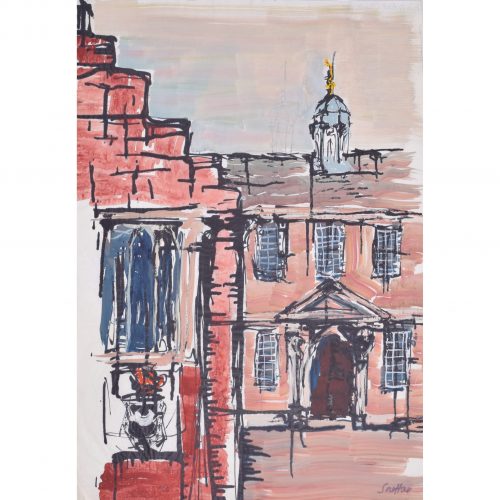
Margaret Souttar (1914 - 1987)
Trinity Hall, Cambridge IV
Acrylic paint 62 x 92 cm Signed lower right. Souttar was a Scottish painter and printmaker known for her images of town- and cityscapes. In the early 1960s, she was commissioned to produce a series of prints of the Cambridge colleges. She captures the modernity and optimism of 1960s Cambridge; the fact that a female artist was commissioned to create the prints reflects the changing attitudes of the University towards women. Trinity Hall was one of the first Cambridge colleges to admit women as students – it did not do so until 1976. Provenance: the artist's studio sale. Condition: generally very good; on thin paper - some crinkling to paper as a result of being painted. Further sketch to reverse. If you are interested, please email info@manningfineart.co.uk or call us on 07929 749056. Click here for other views of Trinity Hall. -
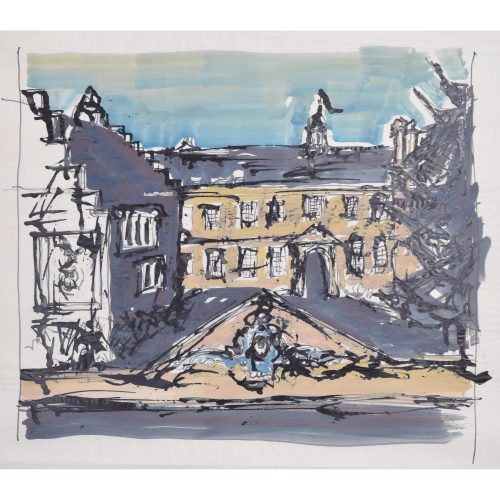
Margaret Souttar (1914 - 1987)
Trinity Hall, Cambridge II
Acrylic paint 56 x 65 cm cm Souttar was a Scottish painter and printmaker known for her town- and cityscapes. In the early 1960s, she was commissioned to produce a series of prints of the Cambridge colleges. She captures the modernity and optimism of 1960s Cambridge; the fact that a female artist was commissioned to create the prints reflects the changing attitudes of the University towards women. Trinity Hall was one of the first Cambridge colleges to admit women as students – it did not do so until 1976.6. Provenance: the artist's studio sale. Condition: generally very good, some crinkling as a result of using water-based paints on thin paper. If you are interested, please email info@manningfineart.co.uk or call us on 07929 749056. Click here for other views of Trinity Hall. -
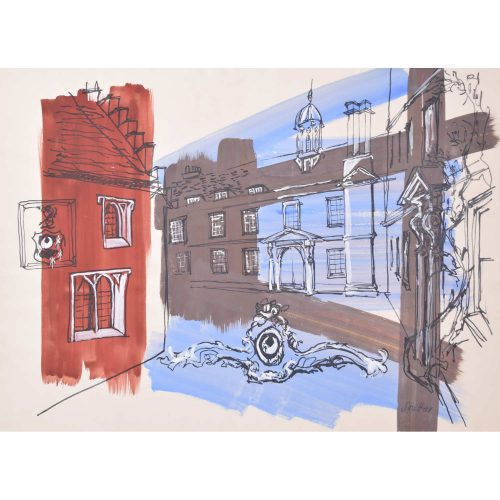
Margaret Souttar (1914 - 1987)
Trinity Hall, Cambridge I
Acrylic paint 55 x 76 cm Signed in pencil lower right. Souttar was a Scottish painter and printmaker known for her images of town- and cityscapes. In the early 1960s, she was commissioned to produce a series of prints of the Cambridge colleges. She captures the modernity and optimism of 1960s Cambridge; the fact that a female artist was commissioned to create the prints reflects the changing attitudes of the University towards women. Trinity Hall was one of the first Cambridge colleges to admit women as students - it did not do so until 1976. Provenance: the artist's studio sale. Condition: generally very good, a few handling marks. If you are interested, please email info@manningfineart.co.uk or call us on 07929 749056. Click here for other views of Trinity Hall. -

Terry Frost (1915-2003)
Autumnal Landscape in Red, Black and Yellow
Watercolour 40 x 58 cm Signed and dated 1958 Framed in hand-finished grey 'Nicholson' butt-jointed frame. Click here for biographical details and other works by the artist. If you are interested email info@manningfineart.co.uk or call us on 07929 749056. In 1954 Frost moved to Leeds to become Gregory Fellow at the University. This began a period when he painted yellow and black and white paintings, inspired by the Yorkshire landscape. In 1958 he joined the London group and then moved to St Ives. This painting dates to this era. -
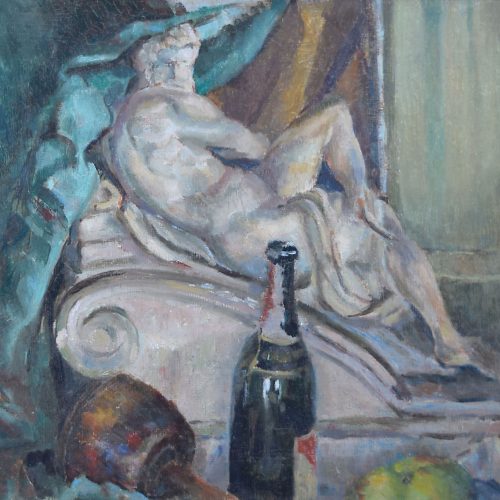 Sir Terry Frost (1915-2003) Bottle and Statue Oil on board c. 1947 38 x 46cm A distinctive still life featuring bottle, statue, and drapery. Terry Frost was a prominent British abstract artist. Frost is most noted for his simplistic abstract forms and unusual colour; he worked alongside the St Ives group and as Barbara Hepworth's assistant for several years, his artistic style being heavily influenced by them. In 1992 he became a Royal Academician, and he was made Sir Terry Frost in 1998. Bottle and Statue highlights Frost's unique compositional skill. His brushwork makes the statue seem like a real nude, who, framed by turquoise and ochre draperies, examines the still life in the foreground. An early work, painted shortly after the War and prior to his adoption of abstraction. For other works by Frost and biographical details please click here. Condition: A little craquelure in the oil above the statue's head.
Sir Terry Frost (1915-2003) Bottle and Statue Oil on board c. 1947 38 x 46cm A distinctive still life featuring bottle, statue, and drapery. Terry Frost was a prominent British abstract artist. Frost is most noted for his simplistic abstract forms and unusual colour; he worked alongside the St Ives group and as Barbara Hepworth's assistant for several years, his artistic style being heavily influenced by them. In 1992 he became a Royal Academician, and he was made Sir Terry Frost in 1998. Bottle and Statue highlights Frost's unique compositional skill. His brushwork makes the statue seem like a real nude, who, framed by turquoise and ochre draperies, examines the still life in the foreground. An early work, painted shortly after the War and prior to his adoption of abstraction. For other works by Frost and biographical details please click here. Condition: A little craquelure in the oil above the statue's head. -
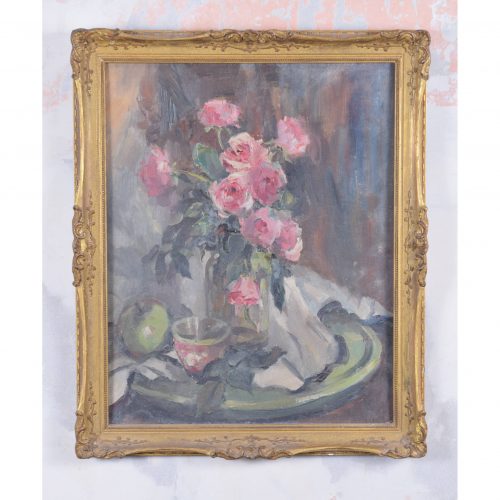
Angela Stones (1914 - 1995)
Still Life with Pink Roses
Oil on board 47 x 37 cm A beautiful still life which moves between pink and green: pink roses and bowl, and green leaves, apples, and plate. Stones' impasto technique brings texture to the fruit and petals, and the blues and browns of the background highlight the brilliance of the roses. Stones was educated at the Chelsea School of Art, and was a member of an artistic dynasty. Her mother Dorothy Bradshaw (1893 - 1983) studied under Jack Merriott – the artist famous for his British Rail posters, and her son, Christopher Assheton-Stones (1947 - 1999), was arguably the foremost pastel artist of his time. Provenance: the family of the artist. Condition: very good; gilt frame has a few repaired small losses. If you are interested, please email info@manningfineart.co.uk or call us on 07929 749056. Click here for other pictures by the artist. -
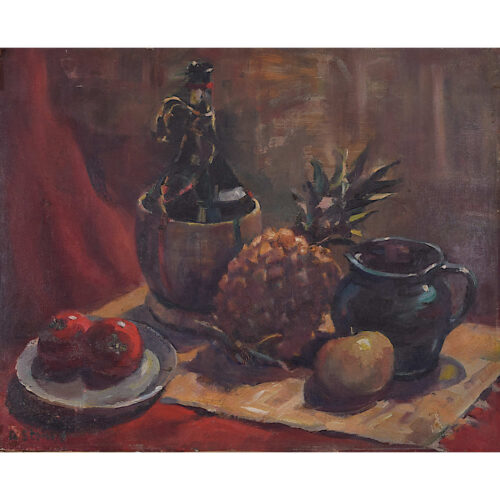
Angela Stones (1914 - 1995)
Still Life with Pineapple
Oil on board 41 x 51 cm Signed lower left. Provenance: the family of the artist. A dark, characterful mid-century still life in oils, characterised by Stones' textured brushwork and rich use of colour. Stones was educated at the Chelsea School of Art, and was a member of an artistic dynasty. Her mother Dorothy Bradshaw (1893-1983) studied under Jack Merriott – the artist famous for his British Rail posters, and her son, Christopher Assheton-Stones (1947 - 1999), was arguably the foremost pastel artist of his time. Condition: very good. If you’d like to know more, please email info@manningfineart.co.uk or call us on 07929 749056. Click here for more still lifes. -
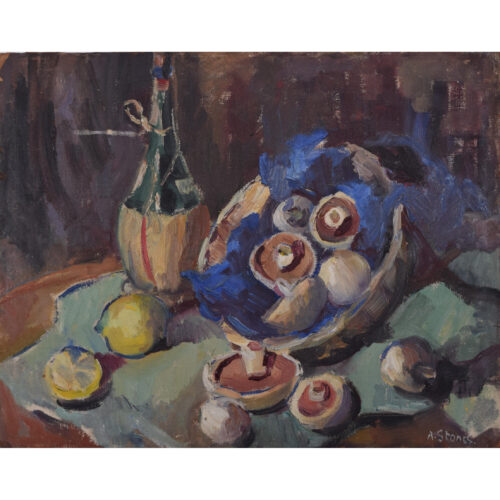
Angela Stones (1914 - 1995)
Still Life with Mushrooms
Oil on board 41 x 51 cm Signed lower right. Provenance: the family of the artist. A dark, characterful mid-century still life in oils, characterised by Stones' textured brushwork and rich use of colour. Stones was educated at the Chelsea School of Art, and was a member of an artistic dynasty. Her mother Dorothy Bradshaw (1893-1983) studied under Jack Merriott – the artist famous for his British Rail posters, and her son, Christopher Assheton-Stones (1947 - 1999), was arguably the foremost pastel artist of his time. Condition: very good. If you’d like to know more, please email info@manningfineart.co.uk or call us on 07929 749056. Click here for more still lifes. -
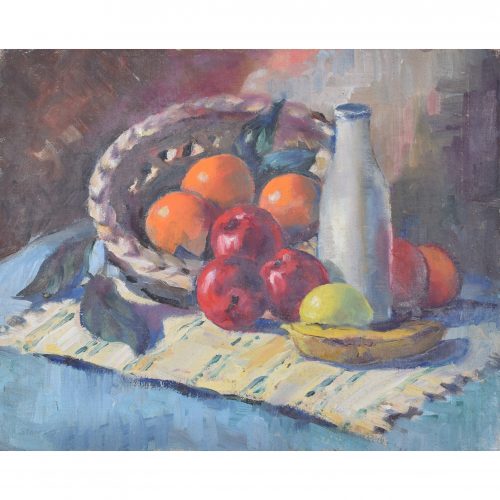
Angela Stones (1914 - 1995)
Still Life with Fruit and Milk Bottle
Oil on board 41 x 51 cm Signed lower left. A mid-century still life in oils, characterised by Stones' textured brushwork and use of vivid colours. Stones was educated at the Chelsea School of Art, and was a member of an artistic dynasty. Her mother Dorothy Bradshaw (1893-1983) studied under Jack Merriott – the artist famous for his British Rail posters, and her son, Christopher Assheton-Stones (1947-1999), was arguably the foremost pastel artist of his time. Provenance: the family of the artist. Condition: very good. If you’d like to know more, please email info@manningfineart.co.uk or call us on 07929 749056. -
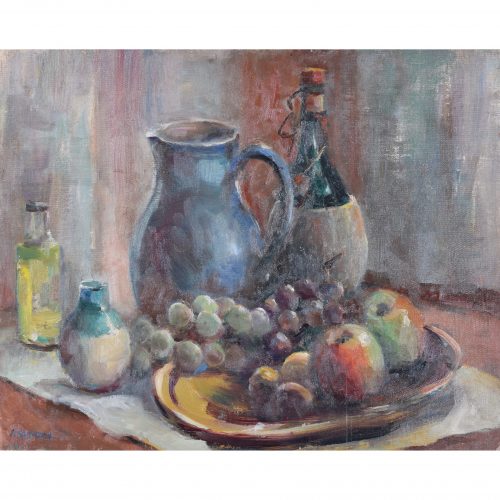
Angela Stones (1914 - 1995)
Still Life with Fruit and Jug
Oil on board 40 x 50 cm Signed lower left. A stylish mid-century still life, characterised by Stones' lively brushwork and rich use of colour. Stones was educated at the Chelsea School of Art, and was a member of an artistic dynasty. Her mother Dorothy Bradshaw (1893-1983) studied under Jack Merriott – the artist famous for his British Rail posters, and her son, Christopher Assheton-Stones (1947-1999), was arguably the foremost pastel artist of his time. Provenance: the family of the artist. Condition: very good. If you’d like to know more, please email info@manningfineart.co.uk or call us on 07929 749056. -

Angela Stones (1914 - 1995)
Still Life with Fruit and Flowers
Oil on board 62 x 46 cm A typically stylish mid-century still life. The citrus fruits in the foreground are the painting's focus, with their peel dancing between reds, greens, yellows, and oranges. Stones was educated at the Chelsea School of Art, and was a member of an artistic dynasty. Her mother Dorothy Bradshaw (1893-1983) studied under Jack Merriott – the artist famous for his British Rail posters, and her son, Christopher Assheton-Stones (1947-1999), was arguably the foremost pastel artist of his time. Provenance: the family of the artist. Condition: very good; recently cleaned and varnished. If you’d like to know more, please email info@manningfineart.co.uk or call us on 07929 749056. -
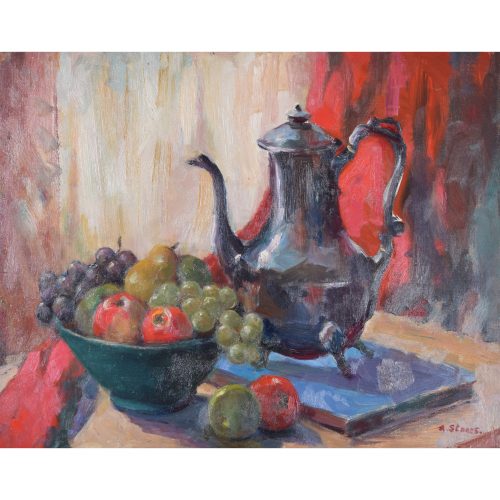
Angela Stones (1914 - 1995)
Still Life with Fruit and Coffee Pot
Oil on board 41 x 51 cm Signed lower right. A sophisticated mid-century still life, characterised by gleaming coffee pot and brimming fruit bowl. The rich red of the apples communicates with the scarlet of the draperies and Stones' signature, just as the bluish-purple hues of the grapes do with the glinting metal of the coffee pot and the blue book on which it stands. Stones was educated at the Chelsea School of Art, and was a member of an artistic dynasty. Her mother Dorothy Bradshaw (1893-1983) studied under Jack Merriott – the artist famous for his British Rail posters, and her son, Christopher Assheton-Stones (1947-1999), was arguably the foremost pastel artist of his time. Provenance: the family of the artist. Condition: very good. If you’d like to know more, please email info@manningfineart.co.uk or call us on 07929 749056. -
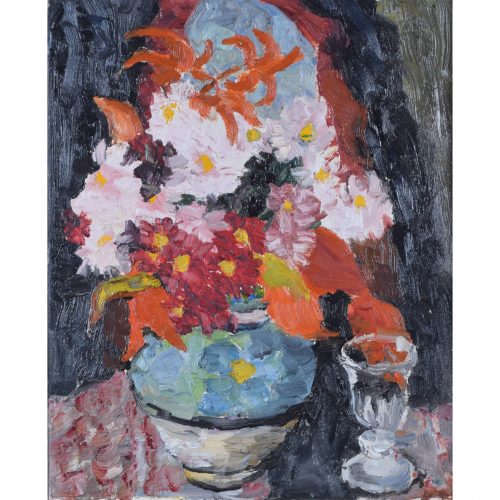
Eva Lucy Harwood (1893 - 1972)
Still Life with Flowers and Glass
Oil on canvas 49 x 40 cm ( 67 x 57 cm framed) A mid-century still life typical of Harwood's impasto style. Lucy Harwood was a British artist who studied art at the Slade just before the outbreak of the First World War. She had initially intended to be a professional pianist, but turned her attentions to visual art after becoming partially paralysed. She was one of the first students to enrol at Cedric Morris' East Anglian School of Drawing and Painting, where she focused on painting Post-Impressionist landscapes, painting just with her left hand. She moved to Upper Layham in Suffolk and is known for her landscapes of the area. Condition: generally very good. Handsome hand-finished frame. Provenance: Louise Kosman, Edinburgh. If you’d like to know more, please email info@manningfineart.co.uk or call us on 07929 749056. Click here to view our other still life pictures. -
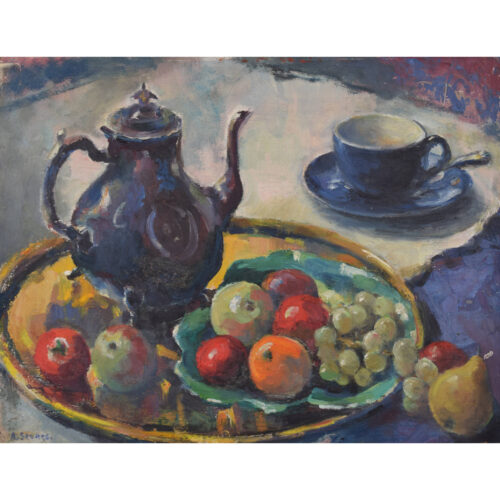
Angela Stones (1914 - 1995)
Still Life with Coffee Pot and Fruit
Oil on board 41 x 51 cm Signed lower right. Provenance: the family of the artist. A mid-century still life in oils, characterised by Stones' textured brushwork, inventive composition, and rich use of colour. Stones was educated at the Chelsea School of Art, and was a member of an artistic dynasty. Her mother Dorothy Bradshaw (1893-1983) studied under Jack Merriott – the artist famous for his British Rail posters, and her son, Christopher Assheton-Stones (1947-1999), was arguably the foremost pastel artist of his time. Condition: very good. If you’d like to know more, please email info@manningfineart.co.uk or call us on 07929 749056. Click here for more still lifes. -
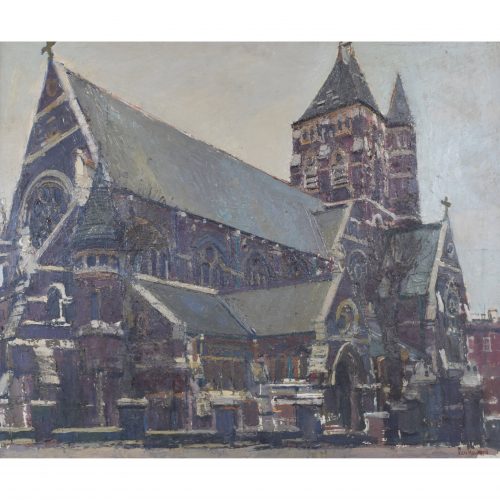
Ken Howard RA (1932 - 2022)
Hampstead Church (St Stephen's Church, Rosslyn Hill)
Oil on board 75 x 91 cm Ken Howard's magnificent view of St Stephen's Church, Hampstead. The artist's rich, deep colour palette and use of impasto underline the neo-gothic style of the church. Howard died in Hampstead and painted several views of the area and its architecture. St Stephen's was designed in the Neo Gothic style by Samuel Sanders Teulon and he considered it the best of the 114 churches he designed, calling it his "mighty church". The building is no longer a church, but wedding ceremonies still take place there; it was made a Grade I listed building in 1974. Kenneth Howard OBE RA was a British artist and painter. He was President of the New English Art Club from 1998 to 2003. He studied at the Hornsey College of Art and the Royal College of Art. In 1958 he won a British Council Scholarship to Florence, and in 1973 and 1978 he was the Official War Artist to Northern Ireland, and 1973 - 80 worked in various locations, including Hong Kong, Cyprus and Canada with the British Army. In 1983 he was elected an Associate of the Royal Academy (ARA). In 1998 he became President of the New English Art Club, a post he held until 2003. In 1991 he was elected a Royal Academician (RA). Howard was given his OBE in 2010. Condition: very good. If you’d like to know more, please email info@manningfineart.co.uk or call us on 07929 749056. -
Out of stock
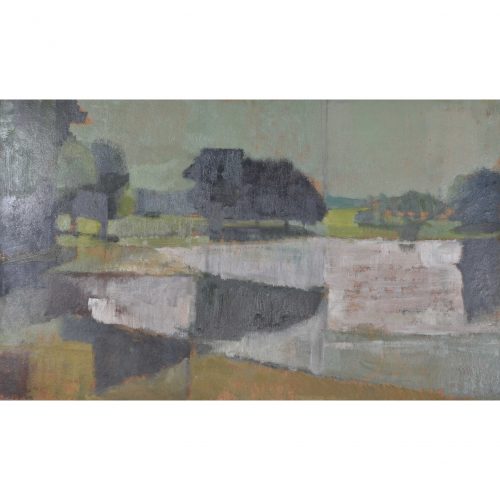
Bernard Myers (1925 - 2007)
South London Park
Oil on board 38 x 64 cm Myers' abstract oil of a London park. Blocks of colour make up the forms of the landscape, textured by the artist's thick, lateral brushstrokes. Bernard Myers was a painter and printmaker who trained at St Martin’s School of Art, the Camberwell School of Arts and Crafts, and the Royal College of Art in the 1940s and 1950s. This painting won the David Murray Landscape Scholarship and was painted while Myers was a student at the RCA. He went on to teach there before moving into a studio in Hammersmith. Condition: very good. Recently cleaned and revarnished. If you’d like to know more, please email info@manningfineart.co.uk or call us on 07929 749056. -
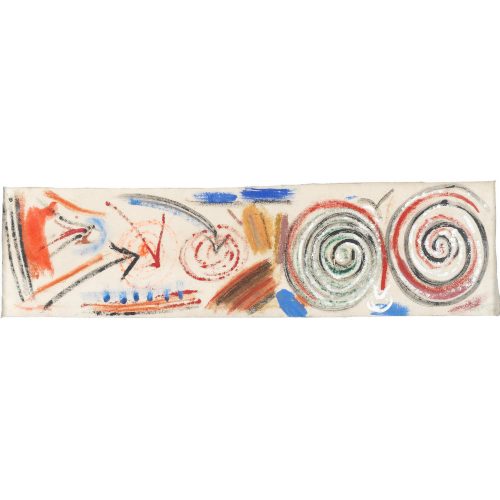
Terry Frost (1915-2003)
'Untitled Landscape'
Oil on canvas, laid on board 22 x 81.5cm Exhibited London, Coram Gallery, Terry Frost: Works on Paper and Small Paintings, 23 September-29 October 1994 Click here for biographical details and other works by the artist. If you are interested email info@manningfineart.co.uk or call us on 07929 749056. -
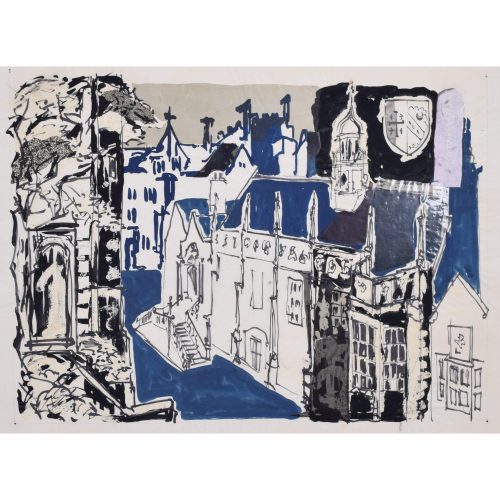
Margaret Souttar (1914 - 1987)
Selwyn College, Cambridge III
Acrylic 51 x 70 cm (image); sheet 67 x 98 cm Inscribed left Selwyn Cambridge '61, with annotations by the artist concerning colour. Souttar was a Scottish painter and printmaker known for her images of town- and cityscapes. In the early 1960s, she was commissioned to produce a series of prints of the Cambridge colleges. She captures the modernity and optimism of 1960s Cambridge; the fact that a female artist was commissioned to create the prints reflects the changing attitudes of the University towards women. These views highlight the layers of history and architectural styles which make up a Cambridge college. Provenance: the artist's studio sale. Condition: generally very good; some crinkling as a result of using water-based paints on thin paper. If you are interested, please email info@manningfineart.co.uk or call us on 07929 749056. Click here for other views of Selwyn College, Cambridge. -
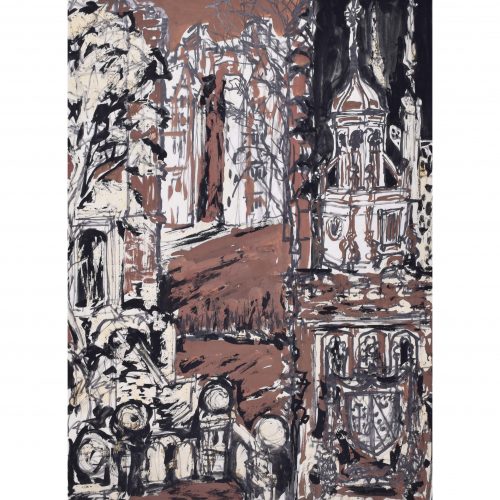
Margaret Souttar (1914 - 1987)
Selwyn College, Cambridge II
Acrylic 71 x 52 cm Souttar was a Scottish painter and printmaker known for her images of town- and cityscapes. In the early 1960s, she was commissioned to produce a series of prints of the Cambridge colleges. She captures the modernity and optimism of 1960s Cambridge; the fact that a female artist was commissioned to create the prints reflects the changing attitudes of the University towards women. These views highlight the layers of history and architectural styles which make up a Cambridge college. Provenance: the artist's studio sale. Condition: generally very good; some crinkling as a result of using water-based paints on thin paper; a little creasing to edges. If you are interested, please email info@manningfineart.co.uk or call us on 07929 749056. Click here for other views of Selwyn College, Cambridge. -
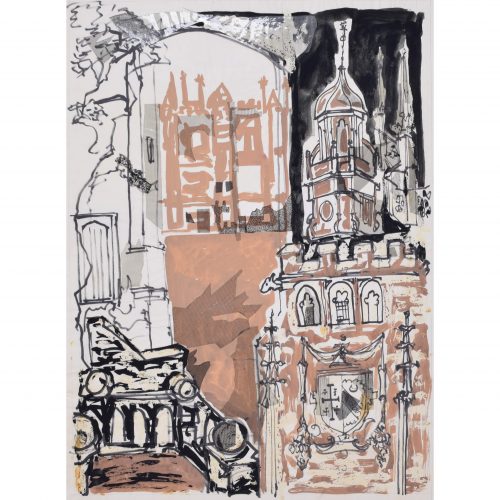
Margaret Souttar (1914 - 1987)
Selwyn College, Cambridge I
Acrylic 70 x 51 cm Souttar was a Scottish painter and printmaker known for her images of town- and cityscapes. In the early 1960s, she was commissioned to produce a series of prints of the Cambridge colleges. She captures the modernity and optimism of 1960s Cambridge; the fact that a female artist was commissioned to create the prints reflects the changing attitudes of the University towards women. These views highlight the layers of history and architectural styles which make up a Cambridge college. Provenance: the artist's studio sale. Condition: generally very good; some crinkling as a result of using water-based paints on thin paper; a little creasing to edges. If you are interested, please email info@manningfineart.co.uk or call us on 07929 749056. Click here for other views of Selwyn College, Cambridge. -
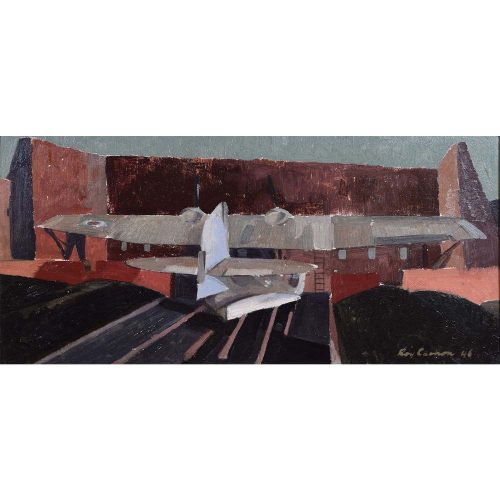
Roy Carnon (1911-2002) Derelict Catalina Redhills Lake near Madras
'Used in Stocks for Gunnery Practice' Oil on board, artist's painted frame Signed and dated 1946 and inscribed with title to reverse Click here for other works by Carnon. This 1946 painting of a derelict Second World War aircraft is a portrait of postwar disillusionment. The battered Catalinas which had survived the war became useful only as ground-based objects for target practice. Carnon's brooding colours and impasto application of paint illustrate how the technologies which helped the Allies to win the war became, overnight, unnecessary. The airmen based in India similarly became unnecessary, but unable to be demobilised they initiated the so-called RAF Mutiny in January 1946. Carnon attended Chiswick Art School becoming an illustrator. In 1965 he was responsible for visualising spacecraft for 2001: A Space Odyssey, being designer of the iconic 'wheel' spacestation. These drawings are now in the Kubrick archives at UAL. If you are interested email info@manningfineart.co.uk or call us on 07929 749056. Condition: Excellent, recently cleaned and in artist's original frame.

